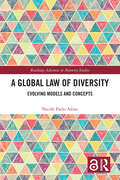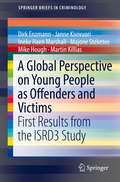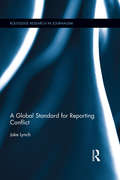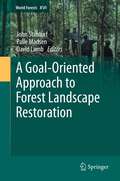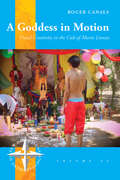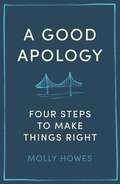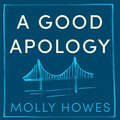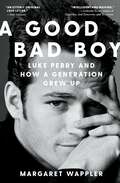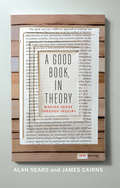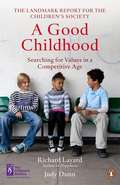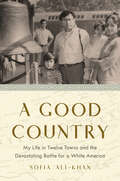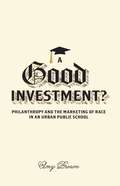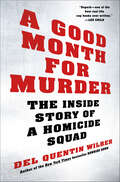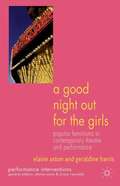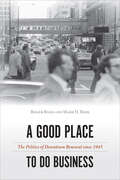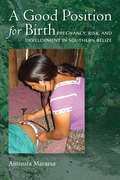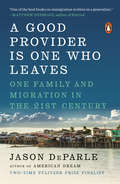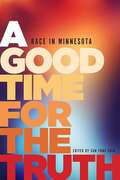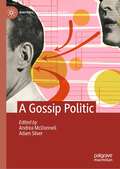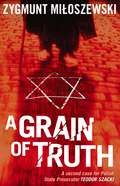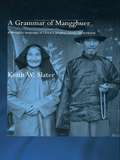- Table View
- List View
A Global Law of Diversity: Evolving Models and Concepts (Routledge Advances in Minority Studies)
by Nicolò Paolo AlessiThis book provides a global perspective on the accommodation of diversity within constitutional traditions, considering the most innovative approaches and legal instruments of the Global North and Global South. This field of study, traditionally dominated by a Global North approach based on majority-minority and rights-based discourse, is undergoing significant development. The work thus assesses the appropriateness of the existing mainstream theoretical tools and concepts – in particular minority and minority-related concepts as well as rights discourse – to grasp the ongoing evolution of this field of law. A reconsideration of the traditional conceptual categories and the introduction of the concept “Law of Diversity” is proposed as a theoretical framework to grasp the ongoing developments in this area. Among the models studied, those that are referred to as emergent models for the accommodation of diversity in the Global North appear to be particularly in need of theoretical recognition. To this end, the theory of federalism is used to serve a rather unexplored theoretical function. Federal theory is put forward as a theoretical instrument to frame and explain the emergent instruments for the accommodation of diversity, as well as provide practical solutions for their development. The book will be of interest to researchers, academics, and policy-makers working in the areas of comparative constitutional law, minority and indigenous rights law, and federal studies.The Open Access version of this book, available at http://www.taylorfrancis.com, has been made available under a Creative Commons Attribution-Non Commercial-No Derivatives (CC-BY-NC-ND) 4.0 license.
A Global Perspective on Young People as Offenders and Victims: First Results from the ISRD3 Study (SpringerBriefs in Criminology)
by Martin Killias Ineke Haen Marshall Majone Steketee Dirk Enzmann Janne Kivivuori Mike HoughThis Brief presents the first major release of findings from the Third International Self-Report Delinquency Study (ISRD3). ISRD is a major international research collaboration that now covers some 35 countries. It surveys young people aged 12 to 16 in their schools, asking about their experience of crime - both as offenders and as victims - and about their attitudes to crime and justice and about their home and school life. ISRD1 was carried out in 1991-1992 and ISRD2 in 2006-2008. ISRD findings presented here cover the 27 ISRD3 countries for which data are already available, with a total sample approaching 63,000 young people. For most of these countries, the samples are drawn from two major cities. This volume provides key findings on self-reported offending and on victimization. Chapter 1 set the scene, and describes the background to ISRD3. Chapter 2 describes the methods used in the survey; respondents complete the ISRD questionnaire either in paper format or - increasingly - using a standardized internet program. Chapter 3 covers key findings on self-reported offending, including the important finding that preparedness to disclose offending varies according to cultural context. Chapter 4 presents findings on victimization, including important new findings on hate crime and the use of parental violence, as well as coverage of more conventional forms of crime. A final chapter summarizes the results and draws out their implications. This Brief will be of interest to researchers in criminology and criminal justice, as well as related fields such as sociology, public policy, and psychology. Due to the groundbreaking methodological analyses provided, this Brief is essential reading to all who conduct or use internationally comparative and global survey research.
A Global Standard for Reporting Conflict (Routledge Research in Journalism)
by Jake LynchA Global Standard for Reporting Conflict constructs an argument from first principles to identify what constitutes good journalism. It explores and synthesises key concepts from political and communication theory to delineate the role of journalism in public spheres. And it shows how these concepts relate to ideas from peace research, in the form of Peace Journalism. Thinkers whose contributions are examined along the way include Michel Foucault, Johan Galtung, John Paul Lederach, Edward Herman and Noam Chomsky, Manuel Castells and Jurgen Habermas. The book argues for a critical realist approach, considering critiques of ‘correspondence’ theories of representation to propose an innovative conceptualisation of journalistic epistemology in which ‘social truths’ can be identified as the basis for the journalistic remit of factual reporting. If the world cannot be accessed as it is, then it can be assembled as agreed – so long as consensus on important meanings is kept under constant review. These propositions are tested by extensive fieldwork in four countries: Australia, the Philippines, South Africa and Mexico.
A Glossary of Words and Phrases in the Oral Performing and Dramatic Literatures of the Jin, Yuan, and Ming (Michigan Monographs In Chinese Studies #89)
by Dale R. JohnsonFor many years, the oral performing and dramatic literatures of China from 1200 to 1600 CE were considered some of the most difficult texts in the Chinese corpus. They included ballad medleys, comic farces, Yuan music dramas, Ming music dramas, and the novel Shuihu zhuan. The Japanese scholars who first dedicated themselves to study these works in the mid-twentieth century were considered daring. As late as 1981, no comprehensive dictionary or glossary for this literature existed in any language, Asian or Western. A Glossary of Words and Phrases fills this gap for Western readers, allowing even a relative novice who has resonable command of Chinese to read, translate, and appreciate this great body of literature with an ease undreamed of even two decades ago. The Glossary is organized into approximately 8,000 entries based on the reading notes and glosses found in various dictionaries, thesauruses, glossaries, and editions of works from the period. Main entries are listed alphabetically in the pinyin romanization system. In addition to glosses, entries include symbolic annotations, guides to pronunciation, and text citations. The result is a broadly useful glossary serving the needs of students of this literature as well as scholars researching Jin and Yuan language and its usage.
A Goal-Oriented Approach to Forest Landscape Restoration (World Forests #16)
by David Lamb John Stanturf Palle MadsenWhile restoration ecology has traditionally aimed to re-create some putative more 'natural' ecological state, forest landscape restoration (FLR) has emerged over the last decade as an approach aimed more at restoring natural functions, while focusing on meeting human needs. With a view to exploring the practical potential of this approach, this book draws together a team of experts from the natural and social sciences to discuss its success so far in addressing critical issues such as biodiversity, ecological function, and human livelihoods. Applying principles of landscape ecology, restoration ecology, planning theory and conflict management, the book presents a series of case studies which document the approach, and discusses how the approach can help with priority setting for the future. The book will provide a valuable reference to graduate students and researchers interested in ecological restoration, forest ecology and management, as well as to professionals in environmental restoration, natural resource management, conservation, and environmental policy.
A Goddess in Motion: Visual Creativity in the Cult of MarÃa Lionza (New Directions in Anthropology #42)
by Roger CanalsThe current practice of the cult of María Lionza is one of the most important and yet unexplored religious practices in Venezuela. Based on long-term fieldwork, this book explores the role of images and visual culture within the cult. By adopting a relational approach, A Goddess in Motion shows how the innumerable images of this goddess-represented as an Indian, white or mestizo woman-move constantly from objects to bodies, from bodies to dreams, and from the religion domain to the art world. In short, this book is a fascinating study that sheds light on the role of visual creativity in contemporary religious manifestations.
A Good Apology: Four steps to make things right
by Molly Howes PhD'Beautifully outlines how our relationships can dramatically improve by an authentic way to repair' Eve Rodsky, bestselling author of Fair Play'Practical, effective remedies that can help make reconciled relationships possible' Bishop Michael B CurryIn the vein of Hold Me Tight and The Body Keeps the Score, this paradigm-shifting book on apologies shows how they work, why they're so hard, and why they are essential for rebuilding relationships.We've all done something wrong or made a mistake or insulted someone - even if by accident. We've all been hurt and wanted the other person to help us heal. It may be surprising, but the breaches themselves aren't the real problem; our inability to fix them is what causes us trouble.In A Good Apology, clinical psychologist Dr. Molly Howes uses her experiences with patients in her practice, research findings, and news stories to illustrate the power and importance of a thorough apology. She teaches how we can all learn to craft an effective apology with four straightforward steps.An apology is a small-scale event between people, but it's enormously powerful. This comprehensive book gives readers the tools to fix their relationships, make amends, and move forward. With it, you'll fully understand the meaning and importance of this universal and timeless endeavour: a good apology.
A Good Apology: Four steps to make things right
by Molly Howes PhD'Beautifully outlines how our relationships can dramatically improve by an authentic way to repair' Eve Rodsky, bestselling author of Fair Play'Practical, effective remedies that can help make reconciled relationships possible' Bishop Michael B CurryIn the vein of Hold Me Tight and The Body Keeps the Score, this paradigm-shifting book on apologies shows how they work, why they're so hard, and why they are essential for rebuilding relationships.We've all done something wrong or made a mistake or insulted someone - even if by accident. We've all been hurt and wanted the other person to help us heal. It may be surprising, but the breaches themselves aren't the real problem; our inability to fix them is what causes us trouble.In A Good Apology, clinical psychologist Dr. Molly Howes uses her experiences with patients in her practice, research findings, and news stories to illustrate the power and importance of a thorough apology. She teaches how we can all learn to craft an effective apology with four straightforward steps.An apology is a small-scale event between people, but it's enormously powerful. This comprehensive book gives readers the tools to fix their relationships, make amends, and move forward. With it, you'll fully understand the meaning and importance of this universal and timeless endeavour: a good apology.
A Good Bad Boy: Luke Perry and How a Generation Grew Up
by Margaret WapplerAn artful and contemplative tribute to the late actor famed for his role as Dylan McKay in Beverly Hills, 90210.Best known for playing loner rebel Dylan McKay in Beverly Hills 90210, Luke Perry was fifty-two years old when he died of a stroke in 2019. There have been other deaths of 90&’s stars, but this one hit different. Gen X was reminded of their own inescapable mortality, and robbed of an exciting career resurgence for one of their most cherished icons—with recent roles in the hit series Riverdale and Quentin Tarantino&’s Once Upon a Time In Hollywood bringing him renewed attention and acclaim. Only upon his death, as stories poured out online about his authenticity and kindness, did it become clear how little was known about the exceedingly humble actor and how deeply he impacted popular culture. In A Good Bad Boy, Margaret Wappler attempts to understand who Perry was and why he was unique among his Hollywood peers. To do so, she uses an inventive hybrid narrative. She speaks with dozens who knew Perry personally and professionally. They share insightful anecdotes: how he kept connected to his Ohio upbringing; nearly blew his 90210 audition; tried to shed his heartthrob image by joining the HBO prison drama Oz; and in the last year of his life, sought to set up two of his newly divorced friends. (After his death, the pair bonded in their grief and eventually married.) Amid these original interviews and exhaustive archival research, Wappler weaves poignant vignettes of memoir in which she serves as an avatar to show how Perry shaped a generation&’s views on masculinity, privilege and the ideal of &“cool.&” Timed to the fifth anniversary of Perry&’s death, A Good Bad Boy is a profound and entertaining examination of what it means to be an artist and an adult.
A Good Book, In Theory: Making Sense Through Inquiry, Third Edition
by Alan Sears James CairnsThis highly original and compelling book offers an introduction to the art and science of social inquiry, including the theoretical and methodological frameworks that support that inquiry. The new edition offers coverage of post-modernism and Indigenous ways of knowing, as well as a discussion of the research process and how to communicate arguments effectively. The result is a book that blends the best of earlier editions with updates that provide a strong foundation in critical thinking, rooted in the social sciences but relevant across disciplines.
A Good Childhood: Searching for Values in a Competitive Age
by Judy Dunn Richard LayardEvery day the newspapers lament the problems facing our children - broken homes, pressures to eat and drink, the stress of exams. The same issues are discussed in every pub and at every dinner party. But is life really more difficult for children than it was, and if so why? And how can we make it better? This book, which is a result of a two year investigation by the Children's Society and draws upon the work of the UK's leading experts in many fields, explores the main stresses and influences to which every child is exposed - family, friends, youth culture, values, and schooling, and will make recommendations as to how we can improve the upbringing of our children. It tackles issues which affect every child, whatever their background, and questions and provides solutions to the belief that life has become so extraordinarily difficult for children in general.The experts make 30 specific recommendations, written not from the point of view of academics, but for the general reader - above all for parents and teachers. We expect publication to be a major event and the centre of widespread media attention.
A Good Country: My Life in Twelve Towns and the Devastating Battle for a White America
by Sofia Ali-KhanA leading advocate for social justice excavates the history of forced migration in the twelve American towns she&’s called home, revealing how White supremacy has fundamentally shaped the nation. &“At a time when many would rather ban or bury the truth, Ali-Khan bravely faces it in this bracing and necessary book.&”—Ayad Akhtar, Pulitzer Prize–winning author of Homeland Elegies Sofia Ali-Khan&’s parents emigrated from Pakistan to America, believing it would be a good country. With a nerdy interest in American folk history and a devotion to the rule of law, Ali-Khan would pursue a career in social justice, serving some of America&’s most vulnerable communities. By the time she had children of her own—having lived, worked, and worshipped in twelve different towns across the nation—Ali-Khan felt deeply American, maybe even a little extra American for having seen so much of the country. But in the wake of 9/11, and on the cusp of the 2016 election, Ali-Khan&’s dream of a good life felt under constant threat. As the vitriolic attacks on Islam and Muslims intensified, she wondered if the American dream had ever applied to families like her own, and if she had gravely misunderstood her home. In A Good Country, Ali-Khan revisits the color lines in each of her twelve towns, unearthing the half-buried histories of forced migration that still shape every state, town, and reservation in America today. From the surprising origins of America&’s Chinatowns, the expulsion of Maroon and Seminole people during the conquest of Florida, to Virginia&’s stake in breeding humans for sale, Ali-Khan reveals how America&’s settler colonial origins have defined the law and landscape to maintain a White America. She braids this historical exploration with her own story, providing an intimate perspective on the modern racialization of American Muslims and why she chose to leave the United States. Equal parts memoir, history, and current events, A Good Country presents a vital portrait of our nation, its people, and the pathway to a better future.
A Good Investment?: Philanthropy and the Marketing of Race in an Urban Public School
by Amy BrownSelect students and teachers worked the room at a fundraising event for a New York City public high school Amy Brown calls College Preparatory Academy. It was their job to convince wealthy attendants that College Prep, with its largely minority and disadvantaged student body and its unusually high rate of graduation and college acceptance, was a worthy investment. To this end, students and teachers tried to seem needy and deserving, hoping to make supporters feel generous, important, and not threatened. How much, Brown asks, does competition for financing in urban public schools depend on marketing and perpetuating poverty in order to thrive? And are the actors in this drama deliberately playing up stereotypes of race and class?A Good Investment? offers a firsthand look behind the scenes of the philanthropic approach to funding public education—a process in which social change in education policy and practice is aligned with social entrepreneurship. The appearance of success, equity, or justice in education, Brown argues, might actually serve to maintain stark inequalities and inhibit democracy. Her book shows that models of corporate or philanthropic charity in education can in fact reinforce the race and class hierarchies that they purport to alleviate.As their voices reveal, the teachers and students on the receiving end of such a system can be critically conscious and ambivalent participants in a school&’s racialized marketing and image management. Timely and provocative, this nuanced work exposes the unintended consequences of an education marketplace where charity masquerades as justice.
A Good Month for Murder: The Inside Story of a Homicide Squad
by Del Quentin WilberBestselling author Del Quentin Wilber tells the inside story of how a homicide squad---a dedicated, colorful team of detectives—does its almost impossible jobTwelve homicides, three police-involved shootings and the furious hunt for an especially brutal killer--February 2013 was a good month for murder in suburban Washington, D.C.After gaining unparalleled access to the homicide unit in Prince George's County, which borders the nation's capital, Del Quentin Wilber begins shadowing the talented, often quirky detectives who get the call when a body falls. After a quiet couple of months, all hell breaks loose: suddenly every detective in the squad is scrambling to solve one shooting and stabbing after another. Meanwhile, the entire unit is obsessed with a stone-cold "red ball," a high-profile case involving a seventeen-year-old honor student attacked by a gunman who kicked down the door to her house and shot her in her bed.Murder is the police investigator's ultimate crucible: to solve a killing, a detective must speak for the dead. More than any recent book, A Good Month for Murder shows what it takes to succeed when the stakes couldn't possibly be higher.
A Good Night Out for the Girls
by Geraldine Harris Elaine AstonTimely, innovative and engaging, A Good Night Out for the Girls (now available in paperback) looks beyond the confines of the paradigms for political theatre that have long been the mainstay of theatre scholarship, embracing cutting edge thinking on the relationship between politics and aesthetics. In a departure from the many feminist theorists and philosophers who over last two to three decades have sought to define the sort of ideal feminism 'we need', this book looks to the field of theatre and performance to investigate the sort of flawed, sometimes confused and contradictory, but nonetheless lived feminisms that a significant number of women have actually got. Spanning the boundaries of mainstream and experimental circuits from the affective pleasures of commercially successful shows such as Calendar Girls and Mamma Mia! to the feminist possibilities of new burlesque and stand-up, the study offers a lucid and accessible account of popular feminisms in contemporary theatre and performance.
A Good Place to Do Business: The Politics of Downtown Renewal since 1945 (Urban Life, Landscape and Policy)
by Roger Biles Mark H. RoseThe “Pittsburgh Renaissance,” an urban renewal effort launched in the late 1940s, transformed the smoky rust belt city’s downtown. Working-class residents and people of color saw their neighborhoods cleared and replaced with upscale, white residents and with large corporations housed in massive skyscrapers. Pittsburgh’s Renaissance’s apparent success quickly became a model for several struggling industrial cities, including St. Louis, Cleveland, Detroit, Chicago, and Philadelphia. In A Good Place to Do Business, Roger Biles and Mark Rose chronicle these urban “makeovers” which promised increased tourism and fashionable shopping as well as the development of sports stadiums, convention centers, downtown parks, and more. They examine the politics of these government-funded redevelopment programs and show how city politics (and policymakers) often dictated the level of success. As city officials and business elites determined to reorganize their downtowns, a deeply racialized politics sacrificed neighborhoods and the livelihoods of those pushed out. Yet, as A Good Place to Do Business demonstrates, more often than not, costly efforts to bring about the hoped-for improvements failed to revitalize those cities, or even their downtowns.
A Good Position for Birth: Pregnancy, Risk, and Development in Southern Belize
by Aminata MaraesaIn order to understand the local realities of health and development initiatives undertaken to reduce maternal and infant mortality, the author accompanied rural health nurses as they traveled to villages accessible only by foot over waterlogged terrain to set up mobile prenatal and well-child clinics. Through sustained interactions with pregnant women, midwives, traditional birth attendants, and bush doctors, Maraesa encountered reproductive beliefs and practices ranging from obeah pregnancy to 'nointing that compete with global health care workers' directives about risk, prenatal care, and hospital versus home birth.Fear and shame are prominent affective tropes that Maraesa uses to understand women's attitudes toward reproduction that are at times contrary to development discourse but that make sense in the lived experiences of the women of southern Belize.
A Good Provider Is One Who Leaves: One Family and Migration in the 21st Century
by Jason DeParle"No matter your politics or home country this will change how you think about the movement of people between poor and rich countries...one of the best books on immigration written in a generation." --Matthew Desmond, author of EvictedThe definitive chronicle of our new age of global migration, told through the multi-generational saga of a Filipino family, by a veteran New York Times reporter and two-time Pulitzer Prize finalist.When Jason DeParle moved into the Manila slums with Tita Comodas and her family three decades ago, he never imagined his reporting on them would span three generations and turn into the defining chronicle of a new age--the age of global migration. In a monumental book that gives new meaning to "immersion journalism," DeParle paints an intimate portrait of an unforgettable family as they endure years of sacrifice and separation, willing themselves out of shantytown poverty into a new global middle class. At the heart of the story is Tita's daughter, Rosalie. Beating the odds, she struggles through nursing school and works her way across the Middle East until a Texas hospital fulfills her dreams with a job offer in the States. Migration is changing the world--reordering politics, economics, and cultures across the globe. With nearly 45 million immigrants in the United States, few issues are as polarizing. But if the politics of immigration is broken, immigration itself--tens of millions of people gathered from every corner of the globe--remains an underappreciated American success. Expertly combining the personal and panoramic, DeParle presents a family saga and a global phenomenon. Restarting her life in Galveston, Rosalie brings her reluctant husband and three young children with whom she has rarely lived. They must learn to become a family, even as they learn a new country. Ordinary and extraordinary at once, their journey is a twenty-first-century classic, rendered in gripping detail.
A Good Reputation: How Residents Fight for an American Barrio
by Elizabeth Korver-Glenn Sarah MayorgaA historic Houston barrio provides an illuminating lens on neighborhood reputation. Neighborhoods have the power to form significant parts of our worlds and identities. A neighborhood’s reputation, however, doesn’t always match up to how residents see themselves or wish to be seen. The distance between residents’ desires and their environment can profoundly shape neighborhood life. In A Good Reputation, sociologists Elizabeth Korver-Glenn and Sarah Mayorga delve into the development and transformation of the reputation of Northside, a predominantly Latinx barrio in Houston. Drawing on two years of ethnographic research and in-depth interviews with residents, developers, and other neighborhood stakeholders, the authors show that people’s perceptions of their neighborhoods are essential to understanding urban inequality and poverty. Korver-Glenn and Mayorga’s empirically detailed account of disputes over neighborhood reputation helps readers understand the complexity of high-poverty urban neighborhoods, demonstrating that gentrification is a more complicated and irregular process than existing accounts of urban inequality would suggest. Offering insightful theoretical analysis and compelling narrative threads from understudied communities, A Good Reputation will yield insights for scholars of race and ethnicity, urban planning, and beyond.
A Good Talk: The Story and Skill of Conversation
by Daniel MenakerA GOOD TALK is an analysis of and guide to that most exclusively human of all activities-- conversation. Drawing on over forty years of experience in American letters, Menaker pinpoints the factors that drive and enliven every good conversation: the vagaries (and joys) of subtext; the deeper structure and meaning of conversational flow; the subliminal signals that guide our disclosures and confessions; and the countless other hurdles we must clear along the way. Moving beyond self-help musings and "how to" advice, he has created a stylish, funny, and surprising book: a celebration of "the most excusively human of all activities." In a time when conversation remains deeply important-- for building relationships, for relaxing, even for figuring out who we are-- and also increasingly imperiled (with Blackberries and texting increasingly in vogue), A GOOD TALK is a refreshing celebration of the subtle adventures of a good conversation.
A Good Time For The Truth: Race In Minnesota
by Sun ShinIn this provocative book, sixteen of Minnesota’s best writers provide a range of perspectives on what it is like to live as a person of color in one of the whitest states in the nation. They give readers a splendid gift: the gift of touching another human being’s inner reality, behind masks and veils and politeness. They bring us generously into experiences that we must understand if we are to come together in real relationships. <p><p> Minnesota communities struggle with some of the nation’s worst racial disparities. As its authors confront and consider the realities that lie beneath the numbers, this book provides an important tool to those who want to be part of closing those gaps.
A Gossip Politic (Rhetoric, Politics and Society)
by Adam Silver Andrea McDonnellThis book makes explicit the historical, technological, and discursive links between gossip as a mode of communication, news media, and contemporary politics. A Gossip Politic advances a new framework of gossip, applying the informal understanding of the term to news talk and political actors. Authored by esteemed scholars in the fields of Political Science, Media Studies, Linguistics, and Sociology, chapters consider the influence of gossip on the press, the American presidency, and the public. A Gossip Politic provides readers with a multi-faceted portrait of the ways in which gossip has influenced media history, shaped our understanding of democracy, and contributed to our current political landscape.
A Grain of Truth
by Antonia Lloyd-Jones Zygmunt Miloszewski"A Grain of Truth, like every great crime novel, digs up more unsettling questions than it does answers; it also demonstrates the seemingly endless possibilities of the form itself to serve as smart social criticism." --Maureen Corrigan, on NPR's Fresh AirPraise for the first novel in the Teodor Szacki series:"In Entanglement Miloszewski takes an engaging look at modern Polish society in this stellar first in a new series starring Warsaw prosecutor Teodor Szacki. Readers will want to see more of the complex, sympathetic Szacki."-Publishers WeeklyIt is spring 2009, and prosecutor Szacki is no longer working in Warsaw-he has said goodbye to his family and to his career in the capital and moved to Sandomierz, a picturesque town full of churches and museums. Hoping to start a "brave new life," Szacki instead finds himself investigating a strange murder case in surroundings both alien and unfriendly.The victim is found brutally murdered, her body drained of blood. The killing bears the hallmarks of legendary Jewish ritual slaughter, prompting a wave of anti-Semitic paranoia in the town, where everyone knows everyone. The murdered woman's husband is bereft, but when Szacki discovers that she had a lover, the husband becomes the prime suspect. Before there's time to arrest him, he is found murdered in similar circumstances. In his investigation Szacki must wrestle with the painful tangle of Polish-Jewish relations and something that happened more than sixty years earlier.Zygmunt Miloszewski was born in Warsaw, Poland, in 1975. His first novel The Intercom was published in 2005 to high acclaim. In 2006 he published The Adder Mountains; in 2010, the crime novel Entanglement; and this year its sequel, A Grain of Truth.
A Grammar of Mangghuer: A Mongolic Language of China's Qinghai-Gansu Sprachbund (Routledge Studies in Asian Linguistics)
by Keith W. SlaterThis book is a grammar of Mangghuer, a Mongolic language spoken by approximately 25,000 people in China's northwestern Qinghai Province. Mangghuer is virtually unknown outside China, and no grammar of Mangghuer has ever been published in any language. The book's primary importance is thus as a systematic grammatical description of a little-known language. The book also makes a significant contribution to comparative Mongolic studies. In addition to the synchronic description of Mangghuer, extensive comparison with other Mongolic languages is included, demonstrating the genetic relationship of Mangghuer within that family. In the course of describing Mangghuer linguistic structures, the book also examines issues of interest to linguistic typologists.
A Grammar of Patwin (Studies in the Native Languages of the Americas)
by Lewis C. LawyerPublished through the Recovering Languages and Literacies of the Americas initiative, supported by the Andrew W. Mellon Foundation. A Native American language formerly spoken in hundreds of communities in the interior of California, Patwin (also known as Wintun Tʼewe) is now spoken by a small but growing number of language revitalizationists and their students. A Grammar of Patwin brings together two hundred years of word lists, notebooks, audio recordings, and manuscripts from archives across the United States and synthesizes this scattered collection into the first published description of the Patwin language. This book shines a light on the knowledge of past speakers and researchers with a clear and well-organized description supported by ample archival evidence. Lewis C. Lawyer addresses the full range of grammatical structure with chapters on phonetics, phonology, nominals, nominal modifiers, spatial terms, verbs, and clauses. At every level of grammatical structure there is notable variation between dialects, and this variation is painstakingly described. An introductory chapter situates the language geographically and historically and also gives a detailed account of previous work on the language and of the archival materials on which the study is based. Throughout the process of writing this book, Lawyer remained in contact with Patwin communities and individuals, who helped to ensure that the content is appropriate from a cultural perspective.
